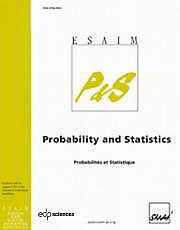Article contents
A Bayesian framework for the ratio of two Poisson rates in the context of vaccine efficacy trials∗
Published online by Cambridge University Press: 03 September 2012
Abstract
In many applications, we assume that two random observations x and
y are generated according to independent Poisson distributions
\hbox{$\PPP(\lambda
S)$} 𝒫(λS)
and \hbox{$\PPP(\mu
T)$}
𝒫(λS)
and \hbox{$\PPP(\mu
T)$} 𝒫(μT)
and we are interested in performing statistical inference on the ratio
φ = λ / μ of the two
incidence rates. In vaccine efficacy trials, x and y are
typically the numbers of cases in the vaccine and the control groups respectively,
φ is called the relative risk and the statistical model is called
‘partial immunity model’. In this paper we start by defining a natural semi-conjugate
family of prior distributions for this model, allowing straightforward computation of the
posterior inference. Following theory on reference priors, we define the reference prior
for the partial immunity model when φ is the parameter of interest. We
also define a family of reference priors with partial information on μ
while remaining uninformative about φ. We notice that these priors belong
to the semi-conjugate family. We then demonstrate using numerical examples that Bayesian
credible intervals for φ enjoy attractive frequentist properties when
using reference priors, a typical property of reference priors.
𝒫(μT)
and we are interested in performing statistical inference on the ratio
φ = λ / μ of the two
incidence rates. In vaccine efficacy trials, x and y are
typically the numbers of cases in the vaccine and the control groups respectively,
φ is called the relative risk and the statistical model is called
‘partial immunity model’. In this paper we start by defining a natural semi-conjugate
family of prior distributions for this model, allowing straightforward computation of the
posterior inference. Following theory on reference priors, we define the reference prior
for the partial immunity model when φ is the parameter of interest. We
also define a family of reference priors with partial information on μ
while remaining uninformative about φ. We notice that these priors belong
to the semi-conjugate family. We then demonstrate using numerical examples that Bayesian
credible intervals for φ enjoy attractive frequentist properties when
using reference priors, a typical property of reference priors.
Keywords
- Type
- Research Article
- Information
- Copyright
- © EDP Sciences, SMAI, 2012
References
Références
- 3
- Cited by




